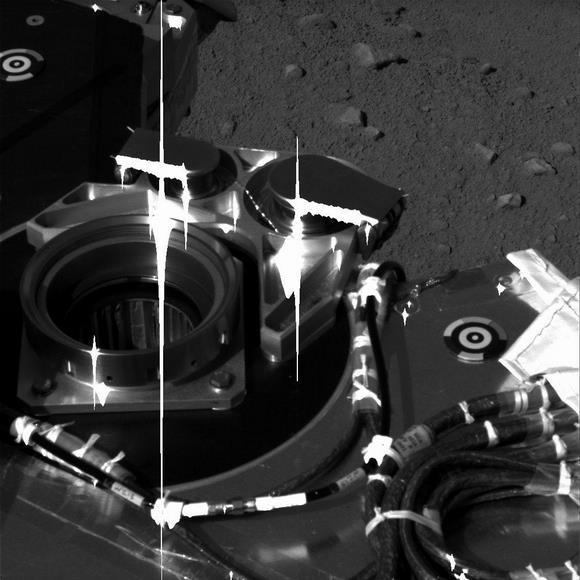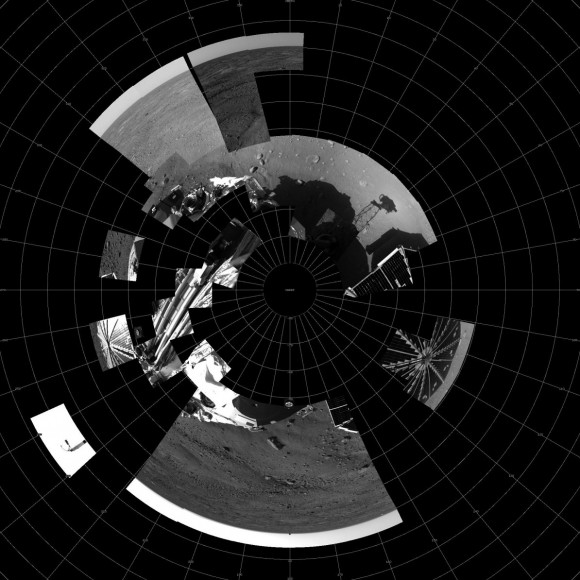The UHF radio on the Mars Reconnaissance Orbiter that had gone into standby mode yesterday was successfully restarted. The orbiter was then able to receive information from the Phoenix Mars Lander late Tuesday evening and relay the transmission to Earth, which included images and other data collected by Phoenix during the mission’s second day after landing on Mars. The radio system used by the orbiter to communicate with the lander experienced an undetermined “transient event” early Tuesday and shut itself off. This prevented sending Phoenix any new commands from Earth on Tuesday. Instead, the lander carried out a backup set of activity commands that had been sent Monday, which included taking additional pictures of itself and the landing site. Above is one of the raw, unprocessed image the lander took of itself.

We’ve gotten used to the panoramic images of Mars from the Mars Exploration Rovers, and we can expect more of the same from Phoenix. Above is the beginnings of a panoramic view of the lander and its surroundings. The Surface Stereo Imager is in the process of taking multiple images, which the imaging team will process and piece together to form a a large color panorama.
And how do these raw, black and white images become colorful photos and panoramas? At left is a calibration target on Phoenix. It has grayscale and color dots. Before launch, the calibration targets are imaged and measured very accurately, so that the imaging team back on Earth knows what the colors and different shades of grey are.
Once on Mars, a picture is taken of the target. The picture will be processed through the software they use, and if it comes out looking the same as the pictures taken of the target before launch, the imaging team knows they have processed the picture correctly. They then use the same technique to process the images of Mars surface, and produce images that are as close as possible to the “real” colors on Mars.
Here’s one more raw image, the beginnings the panorama of the entire spacecraft, of the SSI camera looking down on the spacecraft itself.
Image Source: Phoenix Gallery



Interesting. I wonder how the differing wavelengths of light falling on the calibration wheel itself on Mars will affect ITS perceived color? I.e., on Earth a calibration wheel would look different under sunlight, under an incandescent light bulb, under a fluorescent light bulb, under diffuse lighting vs. direct lighting, etc.
Glad that handshake worked out today.
Good question in regard to the different sorts of light .
I think we should just go there and see for ourselves. Just to be sure. >>
My interest in extra terrestrial observances has been further quenched, seeing pictures (as a child) of far off places always intregued me, here on Earth but to be seeing actual feeds from another planet three or four times in a life time has been more than exquisit, keep up the fantastic work, and may more success be in your stars
Yes good point; the atmosphere of Mars would refract the sunlight and scatter it differently than on Earth, making it appear different to the human eye. Color and light are somewhat relative overall… even my two eyes see color slightly different; my right eye sees more red overall and my left more into the blue.
The whole point to having a calibration target is to have a known reference to start from. This will then provide clues to the color fidelity of the cameras and the true color of Martian sunlight.
The response of the calibration targets would have been characterised very thoroughly. They would have been subjected to a huge array of lighting conditions from many different angles and intensities. It is quite possible that they were subjected to monochromatic light varied over the entire spectral range to fully characterise their reflective properties.
I don’t think it was just a case of snapping a few photos of them in the lab with the digi camera.
that overhead shot is going to be impressive when it’s fully imaged.
maybe this is a dumb question, but, do they just have a black and white camera onboard? why not a HD digital camcorder on a swiveling pole?
BadGuy: Not a dumb question at all. You see, full-color images contain much more information than black and white ones, i.e. the files are much larger. A tiny spacecraft like Phoenix cannot carry a transmitter powerful enough to send 24/7 color TV from Mars, so they had to come up with a way to send as much information as possible using the smallest bandwidth necessary.
Everybody, big smiles
Oh. They can’t see us from here.
bugger.